A cat’s tail is far more than just a fluffy appendage; it’s a dynamic communication tool, offering a fascinating glimpse into their emotional world. While the adage “eyes are the windows to the soul” might hold true for humans, when it comes to cats, their tail movements speak volumes about how they are feeling. Understanding cat tail language is key to deepening your bond with your feline companion and ensuring their well-being.
Why Understanding Cat Tail Language Matters
Learning to interpret your cat’s tail signals is crucial for a harmonious relationship. By paying attention to their tail, alongside other body language cues like ear and eye positions, you can gain valuable insights into your cat’s mood and intentions. This understanding allows you to recognize situations or environments that bring them joy or trigger anxiety. Furthermore, recognizing changes in your cat’s typical tail behavior can even be an early indicator of potential illness or discomfort, prompting timely veterinary attention. Recognizing subtle shifts in tail carriage can be instrumental in identifying discomfort or pain in cats, who are masters at concealing vulnerability.
A Comprehensive Guide to Cat Tail Language
To build a stronger, more trusting, and loving connection with your cat, mastering the basics of cat tail language is essential. Here’s a breakdown of common cat tail positions and their meanings:
The Upright Tail: Confidence and Sociability
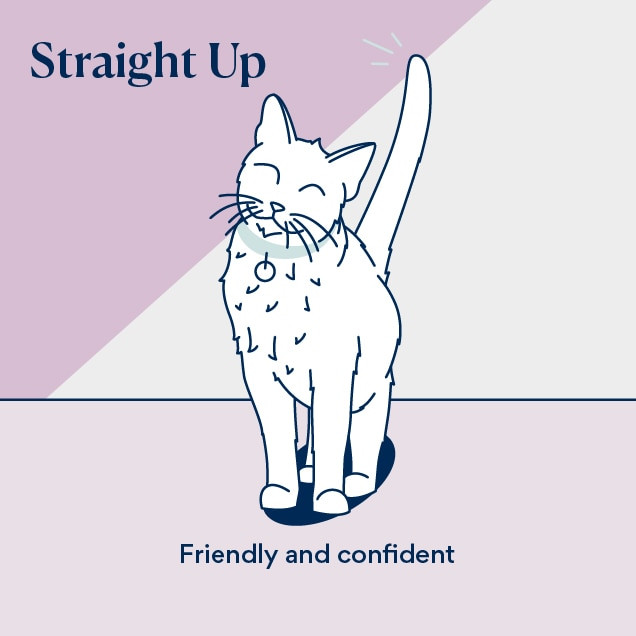 illustration of a happy cat holding their tail straight up
illustration of a happy cat holding their tail straight up
When you observe your cat holding their tail straight up, it’s a clear sign of confidence, sociability, and friendly approachability. This “upright tail cat” is feeling bold and open to interaction. This posture is often used as a friendly greeting between feline friends and is even observed in kittens when they greet their mothers. A study conducted at the University of Southampton in 1997 highlighted the significance of tail position in feline communication. The study revealed that cats were significantly more likely to approach a cat-shaped silhouette with a raised tail, while showing reluctance towards silhouettes with lowered tails. This underscores the powerful communicative role of the upright tail in signaling amicable intentions.
If your cat greets you with an upright tail, it’s an invitation for interaction. This is an ideal moment to offer gentle petting or engage in playful activities, reinforcing your positive bond.
The Question Mark Tail: Happy and Approachable
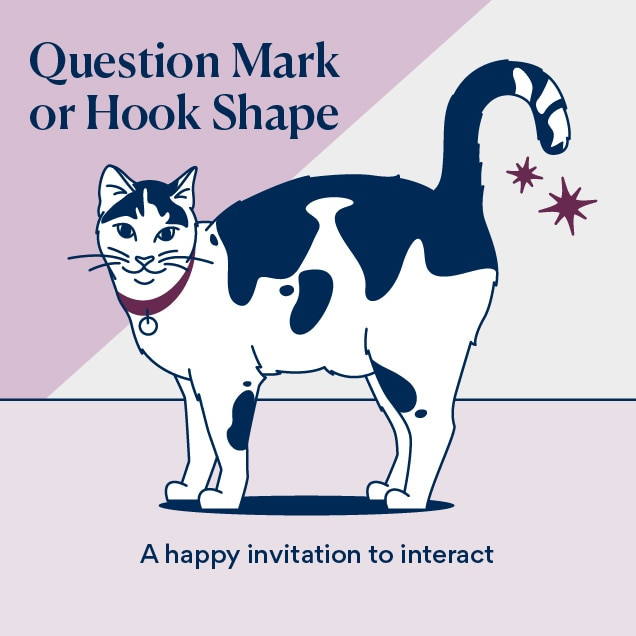 illustration of a cat
illustration of a cat
Sometimes, you might notice your cat’s tail forming a shape resembling a question mark – held upright but with a gentle curl at the tip. This “question mark tail cat” posture is another positive signal, indicating happiness and a friendly, approachable demeanor. Similar to the straight-up tail, the question mark tail signifies your cat is in a good mood and open to interaction. It’s an invitation to engage, suggesting they are feeling playful or affectionate.
While the curled tip might be tempting to touch, remember that most cats prefer being petted around their facial glands – areas like their cheeks, under the chin, and around the ears. Focus your attention on these preferred zones to maximize their enjoyment during interaction.
The Low-Hanging Tail: Fear or Anxiety
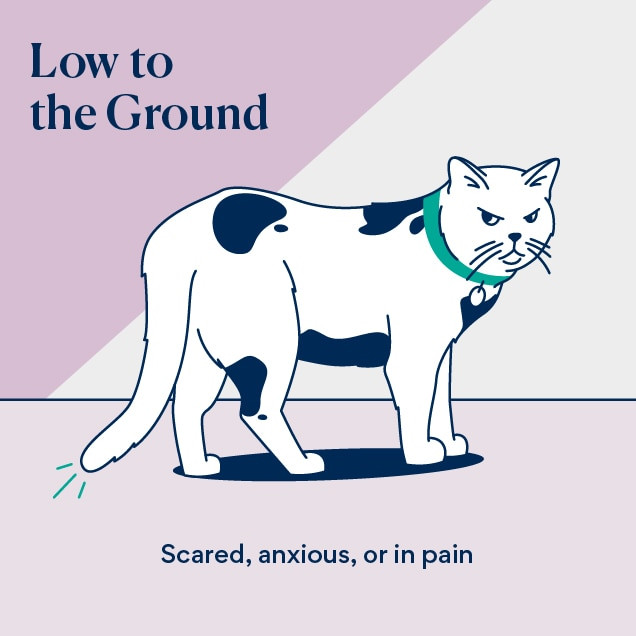 illustration of cat tail language of a tail held low to the ground
illustration of cat tail language of a tail held low to the ground
A cat lowering their tail below their back level is often expressing fear or anxiety. This “low tail cat” posture indicates they are feeling uneasy or threatened. If the tail is tucked firmly between their legs, it signifies a heightened state of fear or even potential pain. A tucked tail is an unambiguous sign of distress, indicating the cat is feeling extremely vulnerable and is attempting to make themselves appear smaller and less threatening.
Identifying this tail position is crucial for recognizing when your cat is feeling stressed or frightened. In such situations, it’s essential to identify and remove any potential stressors from their environment and provide them with a safe and calming space.
The Puffed-Up Tail: Startled or Frightened
 illustration of a cat
illustration of a cat
The classic “Halloween cat” posture, characterized by a puffed-up tail and arched back, is a dramatic display of fear or startle. This “puffed tail cat” is reacting to a sudden, perceived threat. The fur standing on end, known as piloerection, is an involuntary response aimed at making the cat appear larger and more intimidating to potential threats. This is purely a defensive mechanism, signaling that the cat wants to be left alone and is prepared to defend itself if necessary.
Common triggers for this puffed tail position include encounters with unfamiliar animals in the yard, approaching dogs, unfamiliar visitors in the home, or sudden loud noises. It’s vital to recognize this posture as a clear warning signal. Avoid attempting to interact with a cat displaying a puffed tail, as they are likely to perceive any approach as further threat and may react aggressively. The best course of action is to remove the source of their stress and allow them to calm down in a safe space.
The Tail Wrapped Around the Body: Fearful, Defensive, or Unwell
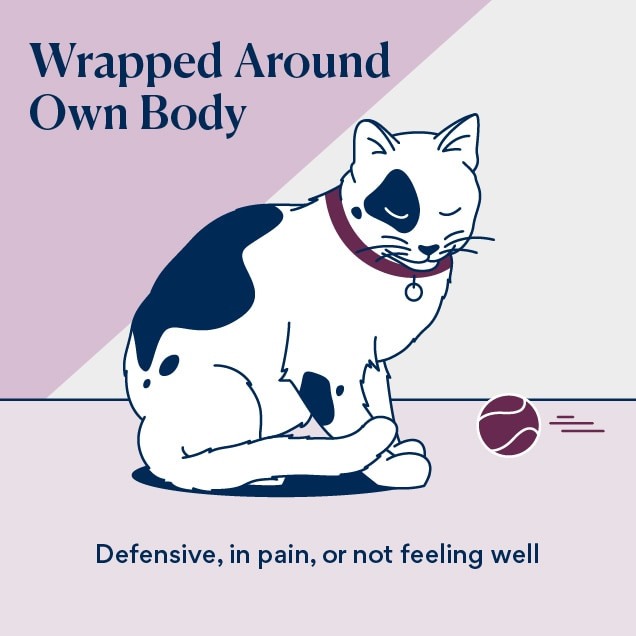 illustration of cat tail language when a cat
illustration of cat tail language when a cat
When a cat is sitting or lying down with their tail wrapped snugly around their body, it often indicates they are feeling fearful, defensive, in pain, or generally unwell. This “tail wrapped around body cat” posture is a sign of withdrawal and self-protection. Wrapping their tail around themselves is a way for cats to provide comfort and security when feeling vulnerable or uncomfortable.
If you observe your cat in this position, it’s important to cease any interaction and assess their environment for potential stressors. Ensure they have a quiet, safe space to retreat to. Persistent crouching with a tightly curled tail for more than a couple of days warrants a veterinary check-up to rule out any underlying pain or illness. This behavior, especially if prolonged, can be a subtle indicator of health issues that require professional attention.
Decoding Cat Tail Wagging: It’s Not Always Happiness
Unlike dogs, tail wagging in cats doesn’t universally equate to happiness. Cats use various tail movements, often described as “wagging,” to express a range of emotions, many of which are distinct from canine tail wags. Understanding the nuances of these “cat tail wagging meaning” is essential for accurate interpretation.
Thrashing Tail: Irritation or Anger
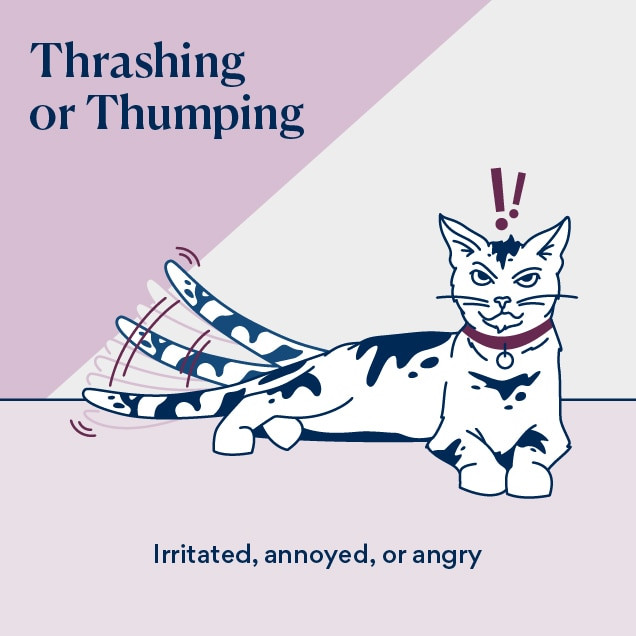 illustration of a cat trashing their tail
illustration of a cat trashing their tail
When a cat thrashes their tail forcefully from side to side or thumps it against the ground, they are signaling irritation, annoyance, or outright anger. This “thrashing tail cat” is communicating displeasure. This is a clear “back off” signal. If you are petting your cat and they begin to thrash their tail, it’s a direct request to stop. Ignoring this signal can escalate the situation, potentially leading to hissing, growling, swatting, or even biting. Respecting this tail language cue is vital for preventing unwanted aggression.
Twitching Tail Tip: Mild Irritation or Focused Attention
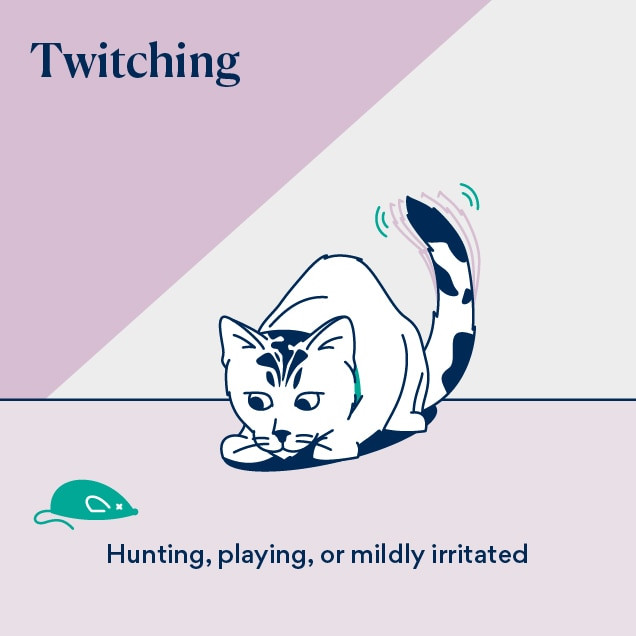 illustration of cat tail language when a cat is twitching their tail
illustration of cat tail language when a cat is twitching their tail
A subtle twitching at the very end of the tail can have different meanings depending on the context. This “twitching tail cat” behavior can indicate focused attention during hunting or play, or it can signal mild irritation or frustration. To correctly interpret a twitching tail, you need to consider the surrounding situation and other body language cues. If they are engaged in play or stalking prey, the twitching likely indicates excitement and focus. However, if there’s no apparent stimulus for play, the twitching tail is more likely a sign of annoyance or impatience.
Swishing Tail: Focused Observation, Potential Pounce
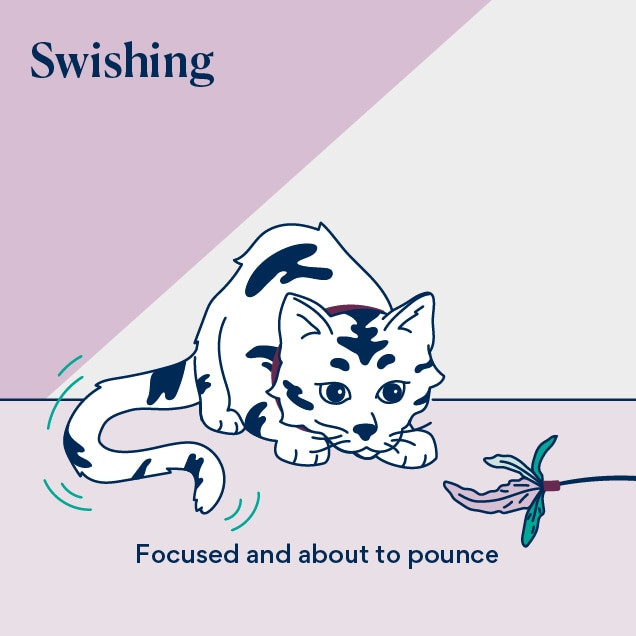 cat tail language illustration of a cat swishing their tail
cat tail language illustration of a cat swishing their tail
A slow, deliberate swishing of the tail from side to side often indicates intense focus. This “swishing tail cat” is likely concentrating on something that has captured their attention, such as a toy, another pet, or something outside. This tail movement frequently precedes predatory behavior. They might be poised to pounce! Allowing your cat to engage in these natural predatory behaviors, like stalking and pouncing, is a great form of enrichment, keeping them mentally and physically stimulated.
Quivering Tail: Excitement or Marking Territory
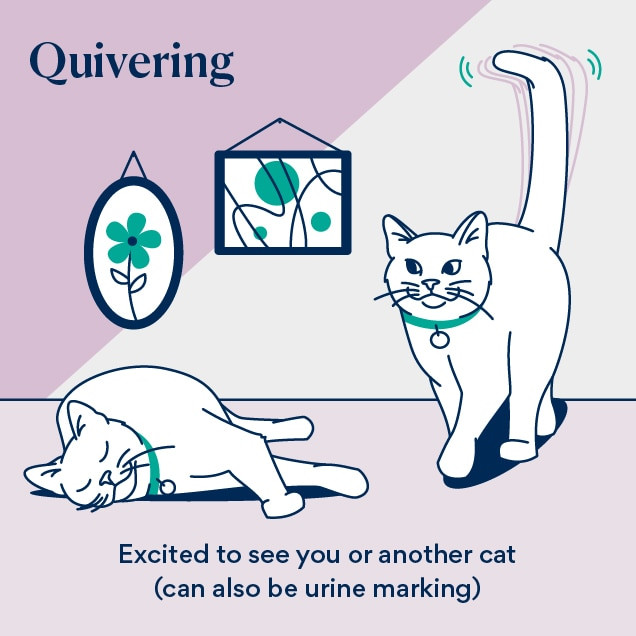 illustration of a cat tail illustration of a quivering tail
illustration of a cat tail illustration of a quivering tail
A quivering or trembling tail usually signifies heightened excitement or anticipation, particularly when greeting you or another familiar cat. This “quivering tail cat” is expressing intense positive emotion. However, it’s important to note that a quivering tail, held straight up while the cat backs up against a vertical surface, can also be a sign of urine marking or spraying. Context is key to differentiating between excitement and marking behavior. If the quivering is accompanied by backing up to a surface, it’s more likely territorial marking.
The Affectionate Tail Wrap: A Feline Hug
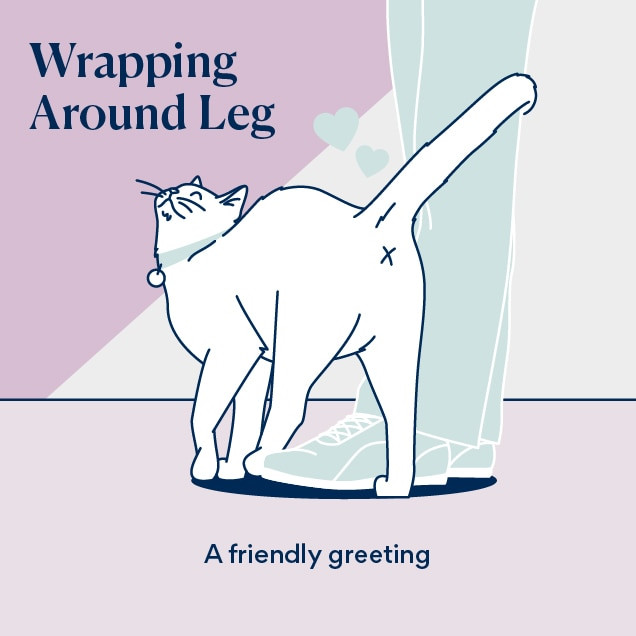 illustration of cat tail language when a cat wraps their tail around human legs
illustration of cat tail language when a cat wraps their tail around human legs
Just as humans use handshakes or hugs as greetings, cats also have their own affectionate gestures. Curling their tail around your legs or intertwining tails with other cats is a sign of affiliation and friendly intention. This “tail wrapped around human cat” behavior is a feline equivalent of a hug. Tail wrapping is a positive social behavior, demonstrating a willingness to interact and bond.
While observing tail movements alone provides valuable insights, remember to consider the entire context of your cat’s body language to fully grasp their emotional state. However, the tail remains one of the most expressive parts of a cat’s anatomy. By learning to understand your cat’s tail language, you’ll undoubtedly strengthen your connection and create a more fulfilling relationship with your beloved feline friend.
WRITTEN BY
Alison Gerken, DVM (Clinical Behavior Resident)
Veterinarian
Dr. Alison Gerken is a second-year resident in veterinary behavior at the Florida Veterinary Behavior Service under the mentorship of…

